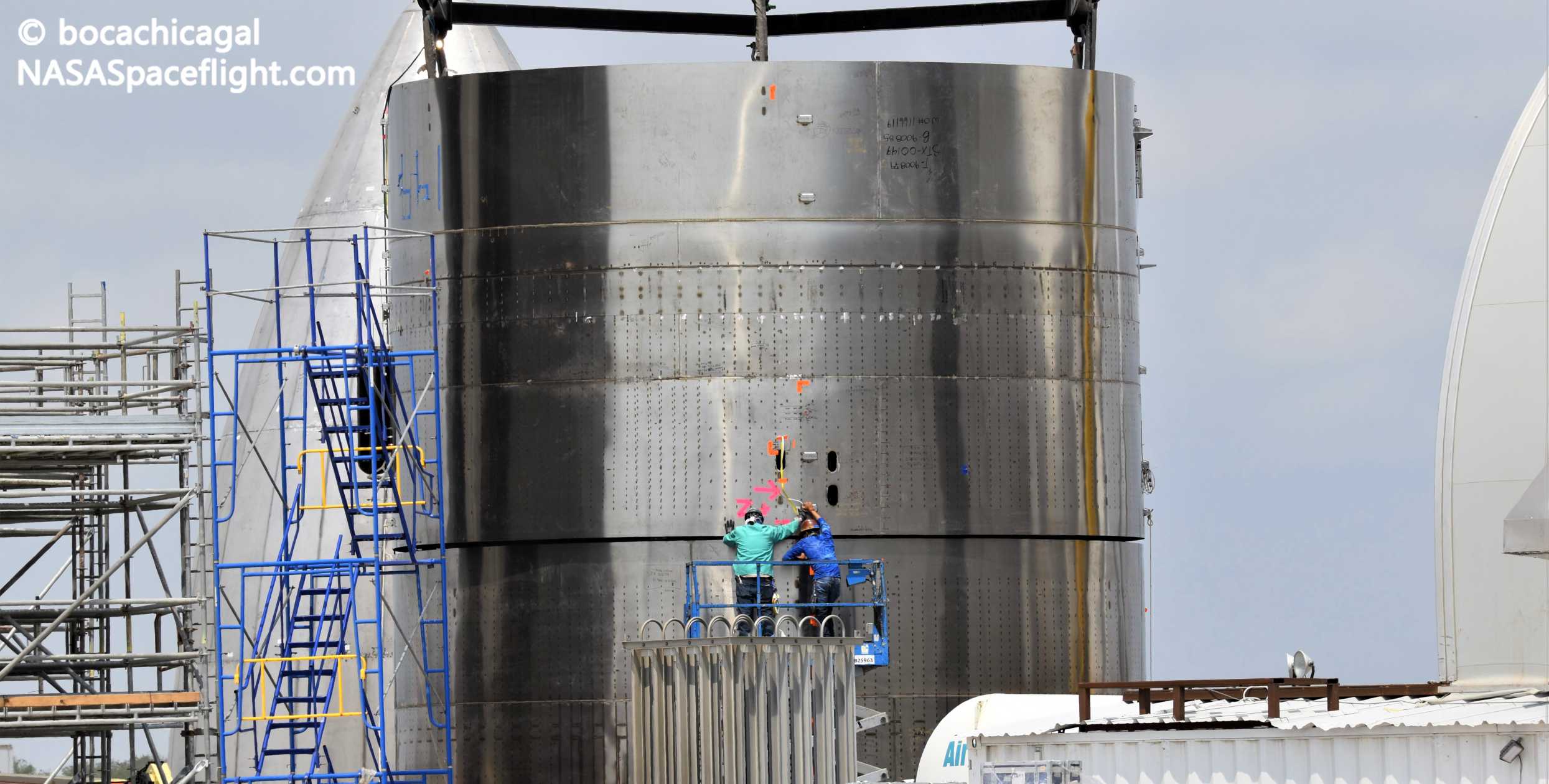

News
SpaceX’s first high-flying, triple-Raptor Starship is almost finished
SpaceX’s first high-flying, triple-engine Starship prototype is rapidly approaching completion at the same time as the company is preparing for the rocket’s predecessor to lift off on its inaugural test flight.
Known as serial number 5 (SN5), it will be the fifth full-scale Starship prototype completed by SpaceX since November 2019 and the fourth since late-January 2020. Following in the footsteps of Mk1, SN1, SN3, and SN4, SpaceX CEO Elon Musk has recently stated that Starship SN5 will be the first prototype to have three Raptor engines and a nosecone installed and could be the first to be outfitted with new and improved aerodynamic control surfaces.
In the meantime, Starship SN4 is perhaps less than 30 hours away from performing a third Raptor static fire test, potentially paving the way for the biggest challenge yet for a full-scale Starship prototype: powered flight. Scheduled no earlier than 9am CDT (14:00 UTC), May 13th, Starship SN4’s next static fire is meant to ensure that a replacement Raptor engine is functioning properly. If successful, the building-sized rocket will effectively be ready to attempt its first launch – also a first for the Starship program overall – pending FAA approval.
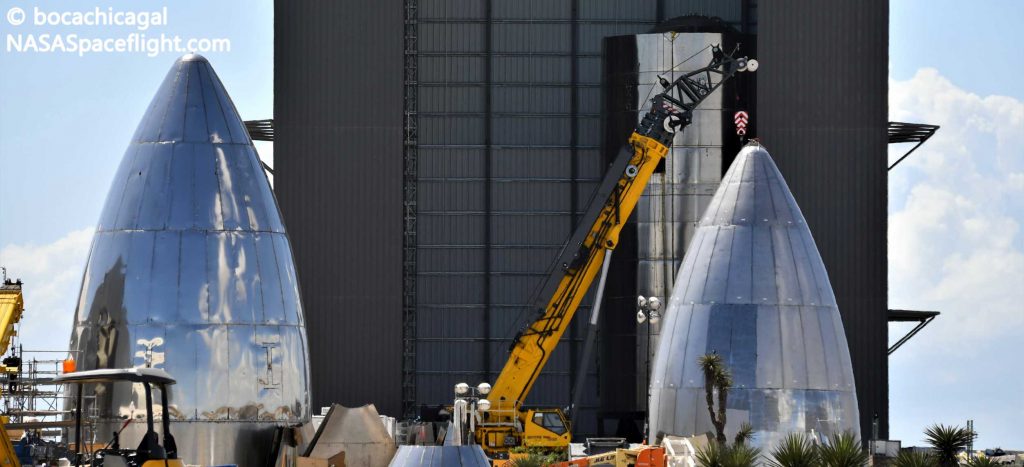
As illustrated in the unofficial diagram above, nearly all of the individual sections that will make up Starship SN5 appear to be more or less complete, excluding some ambiguity added by the interchangeable nature of some of the steel rings all Starships are built out of. For the current design and assembly strategy, Starships are comprised of eight separate sections, themselves made up of stacks of 2-4 steel rings. Altogether, excluding the conical nose section, a single Starship requires approximately 20 of those ~1.8m (6 ft) tall steel rings to reach its full height.
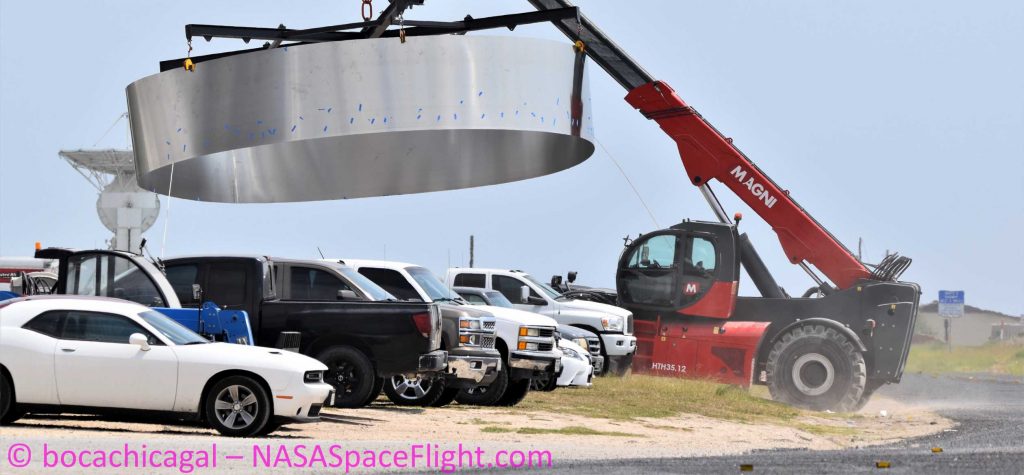
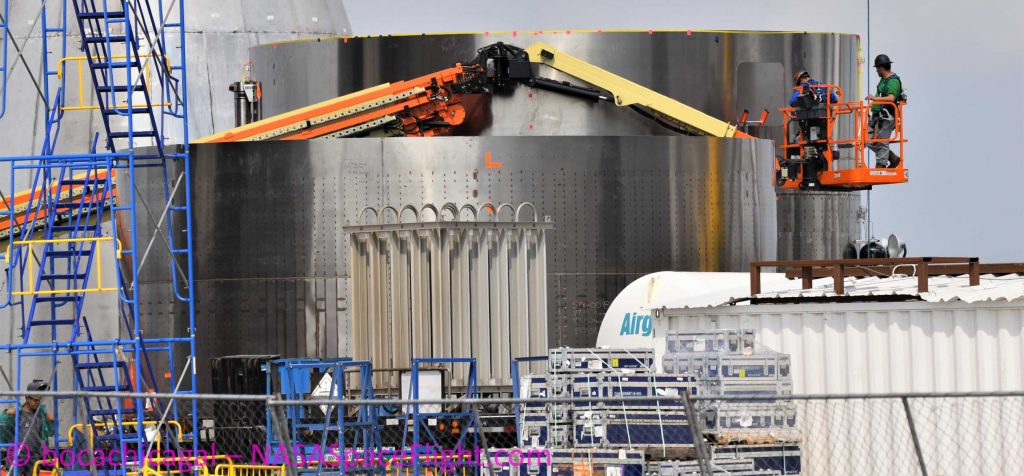
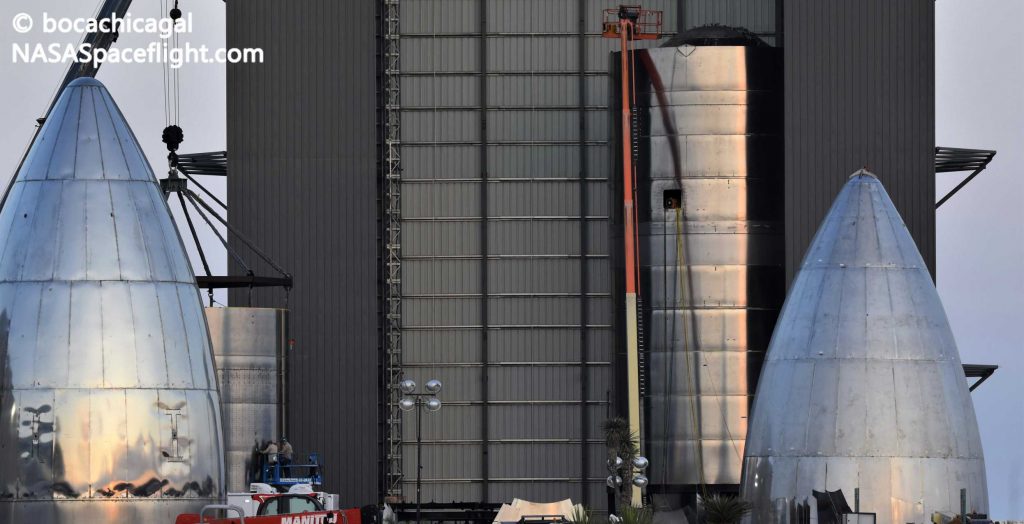
Currently, SpaceX has been focused on testing just the tank section of Starship prototypes, representing the vast majority of the technical challenges that must be solved to fully realize the next-generation launch vehicle’s ambitions. Excluding a smaller secondary liquid oxygen tank situated in the tip of Starship nosecones, the nose section is effectively irrelevant – putting the cart before the horse – until Starship tank sections are more of a known quantity.
When that would be the case was entirely up in the air until just the last week or so, when Starship SN4 became the first full-scale prototype to pass a cryogenic proof test, perform a wet dress rehearsal (WDR) with real propellant, complete static fire(s) with a Raptor engine installed, and – finally – pass a more challenging cryogenic pressure test in quick succession. With those milestones passed for the first time ever, SpaceX has effectively proven that it’s solved the what is arguably the most unprecedented aspect of its Starship program: building orbital-class pressure vessels for pennies on the dollar on the South Texas coast.
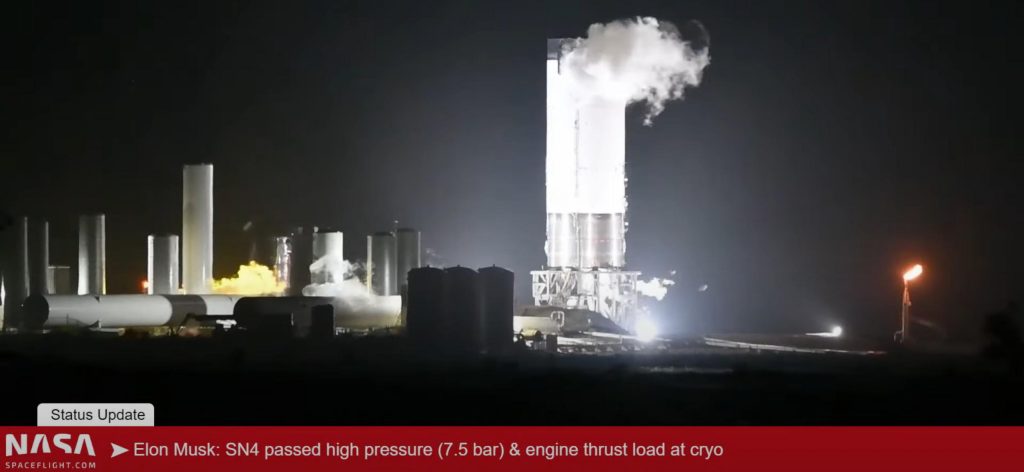
Of course, doing it once with Starship SN4 is not the same as fully confirming that SpaceX’s extremely exotic South Texas rocket factory is capable of producing repeatable results with future rockets. While incredibly improbable, Starship SN4’s multiple successes could be a fluke. Additionally, as Musk has noted, the goal is to complete two entire Starships every week once the factory is fully optimized. SpaceX has already achieved a monthly production rate for its current line of prototypes, an extremely encouraging sign for the practicality of Musk’s stretch goal.
In the prototype stage, that speed of production has been incredibly useful, enabling SpaceX to move at a pace of launch vehicle development almost unheard of since NASA’s Apollo Program. At the moment, Starship SN4 has passed all tests thrown at it so far and will soon be attempting the riskiest Starship test yet with its inaugural hop attempt. If the ship were to be destroyed, one would traditionally expect a bare minimum of a few months of program delay. Instead, Starship SN5 could be more or less complete even before SN4 receives FAA permission for its first flight, meaning that a replacement will already be ready to roll to the launch pad if or when SN4 is destroyed.
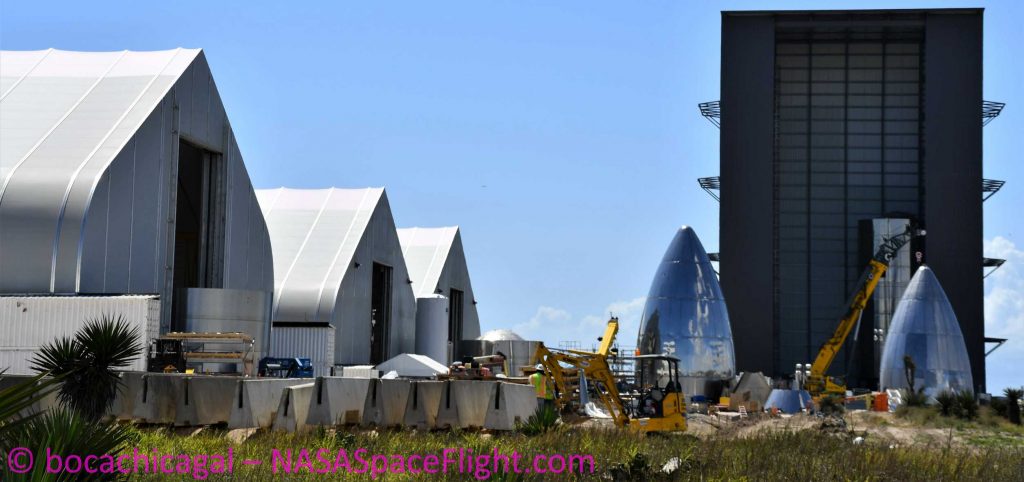
In a best-case scenario, if Starship SN4 continues to pass the tests thrown at it, including one or several hops, SpaceX will instead be entering a new phase indicative of what’s to come: the concurrent testing and operation of a fleet of Starships. A step further, if Starship SN4 succeeds, Starship SN5 appears to be on track to become the first prototype to have a full three Raptor engines and a nosecone installed, as well as the first to attempt a high-altitude (20 km/12 mi) flight test.
Elon Musk
Tesla reveals it is using AI to make factories more sustainable: here’s how
Tesla is using AI in its Gigafactory Nevada factory to improve HVAC efficiency.
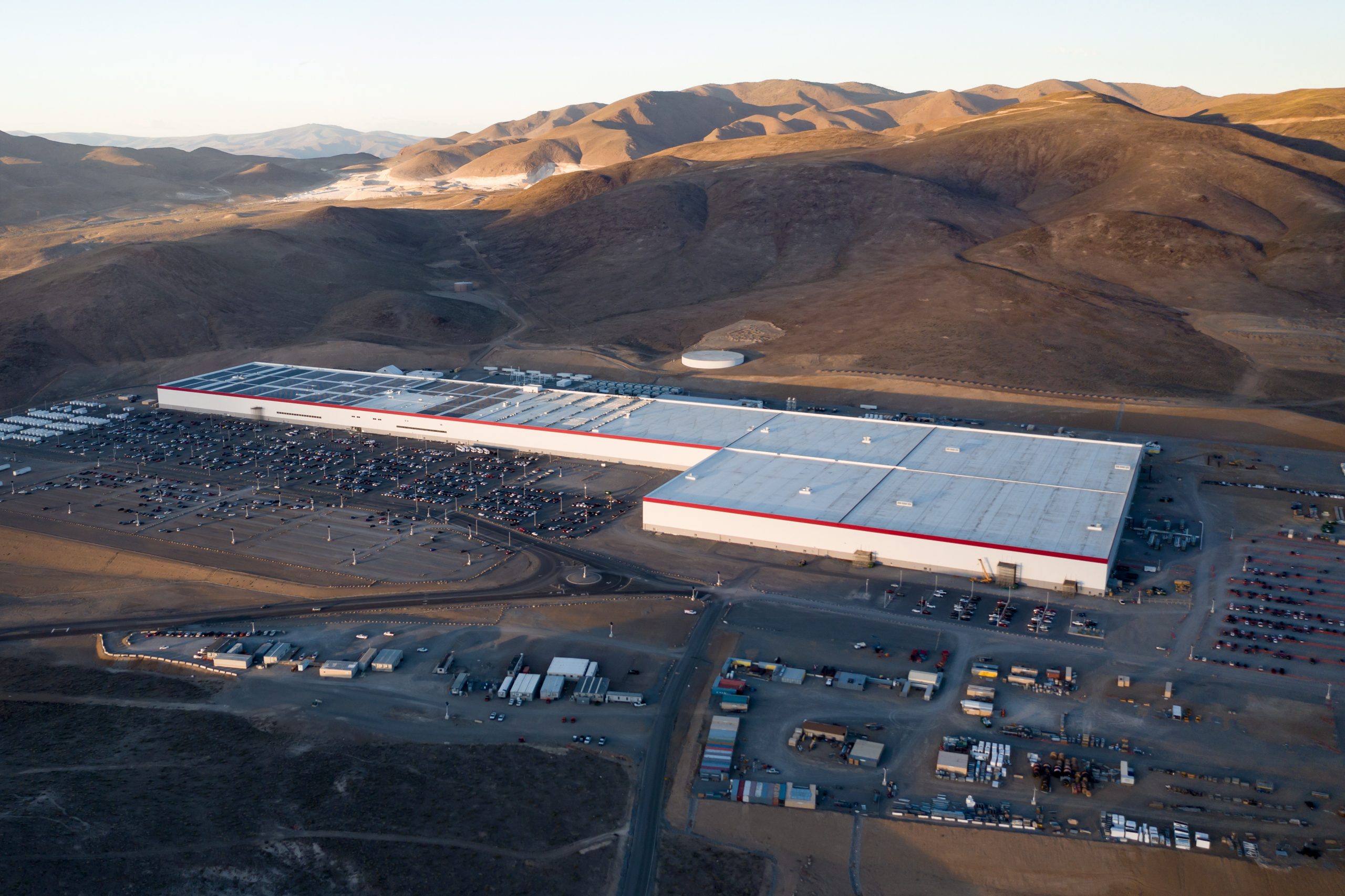
Tesla has revealed in its Extended Impact Report for 2024 that it is using Artificial Intelligence (AI) to enable its factories to be more sustainable. One example it used was its achievement of managing “the majority of the HVAC infrastructure at Gigafactory Nevada is now AI-controlled” last year.
In a commitment to becoming more efficient and making its production as eco-friendly as possible, Tesla has been working for years to find solutions to reduce energy consumption in its factories.
For example, in 2023, Tesla implemented optimization controls in the plastics and paint shops located at Gigafactory Texas, which increased the efficiency of natural gas consumption. Tesla plans to phase out natural gas use across its factories eventually, but for now, it prioritizes work to reduce emissions from that energy source specifically.
It also uses Hygrometric Control Logic for Air Handling Units at Giafactory Berlin, resulting in 17,000 MWh in energy savings each year. At Gigafactory Nevada, Tesla saves 9.5 GWh of energy through the use of N-Methylpyrrolidone refineries when extracting critical raw material.
Perhaps the most interesting way Tesla is conserving energy is through the use of AI at Gigafactory Nevada, as it describes its use of AI to reduce energy demand:
“In 2023, AI Control for HVAC was expanded from Nevada and Texas to now include our Berlin-Brandenburg and Fremont factories. AI Control policy enables HVAC systems within each factory to work together to process sensor data, model factory dynamics, and apply control actions that safely minimize the energy required to support production. In 2024, this system achieved two milestones: the majority of HVAC infrastructure at Gigafactory Nevada is now AI-controlled, reducing fan and thermal energy demand; and the AI algorithm was extended to manage entire chiller plants, creating a closed-loop control system that optimizes both chilled water consumption and the energy required for its generation, all while maintaining factory conditions.”
Tesla utilizes AI Control “primarily on systems that heat or cool critical factory production spaces and equipment.” AI Control communicates with the preexisting standard control logic of each system, and any issues can be resolved by quickly reverting back to standard control. There were none in 2024.
Tesla says that it is utilizing AI to drive impact at its factories, and it has proven to be a valuable tool in reducing energy consumption at one of its facilities.
Elon Musk
Tesla analysts believe Musk and Trump feud will pass
Tesla CEO Elon Musk and U.S. President Donald Trump’s feud shall pass, several bulls say.

Tesla analysts are breaking down the current feud between CEO Elon Musk and U.S. President Donald Trump, as the two continue to disagree on the “Big Beautiful Bill” and its impact on the country’s national debt.
Musk, who headed the Department of Government Efficiency (DOGE) under the Trump Administration, left his post in May. Soon thereafter, he and President Trump entered a very public and verbal disagreement, where things turned sour. They reconciled to an extent, and things seemed to be in the past.
However, the second disagreement between the two started on Monday, as Musk continued to push back on the “Big Beautiful Bill” that the Trump administration is attempting to sign into law. It would, by Musk’s estimation, increase spending and reverse the work DOGE did to trim the deficit.
Every member of Congress who campaigned on reducing government spending and then immediately voted for the biggest debt increase in history should hang their head in shame!
And they will lose their primary next year if it is the last thing I do on this Earth.
— Elon Musk (@elonmusk) June 30, 2025
President Trump has hinted that DOGE could be “the monster” that “eats Elon,” threatening to end the subsidies that SpaceX and Tesla receive. Musk has not been opposed to ending government subsidies for companies, including his own, as long as they are all abolished.
How Tesla could benefit from the ‘Big Beautiful Bill’ that axes EV subsidies
Despite this contentious back-and-forth between the two, analysts are sharing their opinions now, and a few of the more bullish Tesla observers are convinced that this feud will pass, Trump and Musk will resolve their differences as they have before, and things will return to normal.
ARK Invest’s Cathie Wood said this morning that the feud between Musk and Trump is another example of “this too shall pass:”
BREAKING: CATHIE WOOD SAYS — ELON AND TRUMP FEUD “WILL PASS” 👀 $TSLA
She remains bullish ! pic.twitter.com/w5rW2gfCkx
— TheSonOfWalkley (@TheSonOfWalkley) July 1, 2025
Additionally, Wedbush’s Dan Ives, in a note to investors this morning, said that the situation “will settle:”
“We believe this situation will settle and at the end of the day Musk needs Trump and Trump needs Musk given the AI Arms Race going on between the US and China. The jabs between Musk and Trump will continue as the Budget rolls through Congress but Tesla investors want Musk to focus on driving Tesla and stop this political angle…which has turned into a life of its own in a roller coaster ride since the November elections.”
Tesla shares are down about 5 percent at 3:10 p.m. on the East Coast.
Elon Musk
Tesla scrambles after Musk sidekick exit, CEO takes over sales
Tesla CEO Elon Musk is reportedly overseeing sales in North America and Europe, Bloomberg reports.

Tesla scrambled its executives around following the exit of CEO Elon Musk’s sidekick last week, Omead Afshar. Afshar was relieved of his duties as Head of Sales for both North America and Europe.
Bloomberg is reporting that Musk is now overseeing both regions for sales, according to sources familiar with the matter. Afshar left the company last week, likely due to slow sales in both markets, ending a seven-year term with the electric automaker.
Tesla’s Omead Afshar, known as Elon Musk’s right-hand man, leaves company: reports
Afshar was promoted to the role late last year as Musk was becoming more involved in the road to the White House with President Donald Trump.
Afshar, whose LinkedIn account stated he was working within the “Office of the CEO,” was known as Musk’s right-hand man for years.
Additionally, Tom Zhu, currently the Senior Vice President of Automotive at Tesla, will oversee sales in Asia, according to the report.
It is a scramble by Tesla to get the company’s proven executives over the pain points the automaker has found halfway through the year. Sales are looking to be close to the 1.8 million vehicles the company delivered in both of the past two years.
Tesla is pivoting to pay more attention to the struggling automotive sales that it has felt over the past six months. Although it is still performing well and is the best-selling EV maker by a long way, it is struggling to find growth despite redesigning its vehicles and launching new tech and improvements within them.
The company is also looking to focus more on its deployment of autonomous tech, especially as it recently launched its Robotaxi platform in Austin just over a week ago.
However, while this is the long-term catalyst for Tesla, sales still need some work, and it appears the company’s strategy is to put its biggest guns on its biggest problems.
-

 Elon Musk1 day ago
Elon Musk1 day agoTesla investors will be shocked by Jim Cramer’s latest assessment
-

 News6 days ago
News6 days agoTesla Robotaxi’s biggest challenge seems to be this one thing
-

 News2 weeks ago
News2 weeks agoTesla’s Grok integration will be more realistic with this cool feature
-

 Elon Musk2 weeks ago
Elon Musk2 weeks agoElon Musk slams Bloomberg’s shocking xAI cash burn claims
-

 News2 weeks ago
News2 weeks agoTesla China roars back with highest vehicle registrations this Q2 so far
-

 News2 weeks ago
News2 weeks agoTexas lawmakers urge Tesla to delay Austin robotaxi launch to September
-

 News2 weeks ago
News2 weeks agoTesla dominates Cars.com’s Made in America Index with clean sweep
-

 Elon Musk1 week ago
Elon Musk1 week agoFirst Look at Tesla’s Robotaxi App: features, design, and more




















